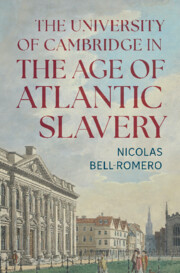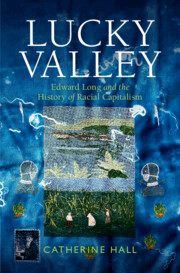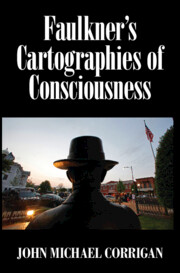Refine search
Actions for selected content:
44 results
1 - ‘The principal ingredient necessary to form a good planter’: Education and the Making of a Transatlantic Elite
-
- Book:
- The University of Cambridge in the Age of Atlantic Slavery
- Published online:
- 12 September 2025
- Print publication:
- 30 October 2025, pp 19-48
-
- Chapter
-
- You have access
- Open access
- HTML
- Export citation
Introduction
-
- Book:
- The University of Cambridge in the Age of Atlantic Slavery
- Published online:
- 12 September 2025
- Print publication:
- 30 October 2025, pp 1-18
-
- Chapter
-
- You have access
- Open access
- HTML
- Export citation
Chapter 9 - Sugar
- from Part III - Applications
-
-
- Book:
- Commodities and Literature
- Published online:
- 14 October 2025
- Print publication:
- 09 October 2025, pp 163-178
-
- Chapter
- Export citation

The University of Cambridge in the Age of Atlantic Slavery
-
- Published online:
- 12 September 2025
- Print publication:
- 30 October 2025
-
- Book
-
- You have access
- Open access
- Export citation
Conclusion: The Outcome of an Experiment
-
- Book:
- A Black Army
- Published online:
- 16 June 2025
- Print publication:
- 17 July 2025, pp 252-271
-
- Chapter
- Export citation
6 - A “Plantation”?
-
- Book:
- A Black Army
- Published online:
- 16 June 2025
- Print publication:
- 17 July 2025, pp 122-133
-
- Chapter
- Export citation
Chapter 7 - Plantation
- from Part II - Developments
-
-
- Book:
- Space and Literary Studies
- Published online:
- 07 May 2025
- Print publication:
- 22 May 2025, pp 120-139
-
- Chapter
- Export citation
Chapter 3 - The Global South
-
-
- Book:
- The New Nineteenth-Century American Literary Studies
- Published online:
- 02 January 2025
- Print publication:
- 23 January 2025, pp 39-52
-
- Chapter
- Export citation
2 - Stateless in South Asia
- from Part I - Asia and the Phenomenon of Statelessness
-
-
- Book:
- Statelessness in Asia
- Published online:
- 19 December 2024
- Print publication:
- 23 January 2025, pp 41-62
-
- Chapter
- Export citation
Epilogue
-
- Book:
- Villa and Palace in the Venetian Renaissance
- Published online:
- 12 December 2024
- Print publication:
- 09 January 2025, pp 291-312
-
- Chapter
- Export citation
Introduction
-
- Book:
- Milton's Ireland
- Published online:
- 14 November 2024
- Print publication:
- 12 December 2024, pp 1-29
-
- Chapter
- Export citation
5 - Monocultures and the Rise of Diversity in Agroecology
-
- Book:
- The Dialectical Agroecologist
- Published online:
- 31 October 2024
- Print publication:
- 14 November 2024, pp 99-116
-
- Chapter
- Export citation
3 - The Plantation
- from Part II - The Lineaments of Racial Capitalism
-
- Book:
- Lucky Valley
- Published online:
- 11 January 2024
- Print publication:
- 22 February 2024, pp 87-155
-
- Chapter
- Export citation

Lucky Valley
- Edward Long and the History of Racial Capitalism
-
- Published online:
- 11 January 2024
- Print publication:
- 22 February 2024
Chapter 5 - Beyond the Tyranny of Textual Space
-
- Book:
- Faulkner's Cartographies of Consciousness
- Published online:
- 02 November 2023
- Print publication:
- 16 November 2023, pp 145-178
-
- Chapter
- Export citation
Chapter 1 - Murder in the House of Memory
-
- Book:
- Faulkner's Cartographies of Consciousness
- Published online:
- 02 November 2023
- Print publication:
- 16 November 2023, pp 18-42
-
- Chapter
- Export citation

Faulkner's Cartographies of Consciousness
-
- Published online:
- 02 November 2023
- Print publication:
- 16 November 2023
32 - Southern Modernism
- from Part III - Situating US Modernism
-
-
- Book:
- The Cambridge History of American Modernism
- Published online:
- 13 July 2023
- Print publication:
- 20 July 2023, pp 541-556
-
- Chapter
- Export citation
Chapter 2 - Marginality, Incivility and Degeneration in Elizabethan England and Ireland
-
- Book:
- Human Empire
- Published online:
- 14 April 2022
- Print publication:
- 21 April 2022, pp 61-102
-
- Chapter
- Export citation
Chapter 2 - Slavery and the Anthropocene
- from Part I - Environmental Histories
-
-
- Book:
- The Cambridge Companion to American Literature and the Environment
- Published online:
- 10 March 2022
- Print publication:
- 17 March 2022, pp 29-43
-
- Chapter
- Export citation
